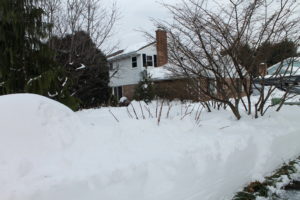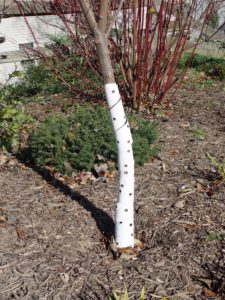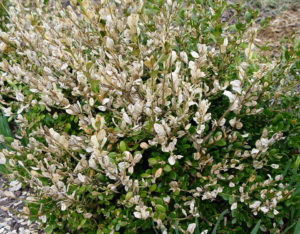Snowy Winter Ahead?
October 11th, 2016
I read AccuWeather’s long-term forecast for this winter with a touch of dread.
The projection is for temperatures 3 to 4 degrees below average with a lot of “snow events.”
I don’t care for even normal winters (whatever they are anymore), so this supposedly cold and snowy one isn’t one I’m looking forward to.
The promising part is that forecasts are often wrong even a day or two out, so this could be a sign that we’re in for a clear and balmy winter.
On the other hand, AccuWeather could be wrong in that things will be even worse than the projection.
The bottom line is that we’ll get what we get when we get it – and have to roll with the punches as they happen.
We can do a few things now, though, to nurse our plants through any coming vortexes and/or snowmageddons. Here are eight “do’s” and four “no-do’s.”
1.) Keep the soil damp. Forget that old advice to not water in fall because dry soil encourages plants to go dormant.
Plants – especially new ones – withstand cold temperatures better when their roots are well hydrated. Keep the hose handy and soak the ground whenever it’s dry, right up until the ground freezes.
2.) A mulch blanket. A 2- to 3-inch layer of organic mulch (shredded hardwood, bark chips, leaves, etc.) and a winter-long snow cover are the two best insulators to keep plant roots from freezing to death.
It’s not too late to add mulch now if you don’t already have enough in place. And if AccuWeather is right, we won’t have to worry about the snow part.
3.) Burlap the evergreens. Burlap barriers do an excellent job of keeping cold winter winds from browning (and possibly killing) the evergreens, especially broad-leaf ones.
They also act as a “sun umbrella” to keep winter sunlight from activating growth during the day, then killing it when temperatures nosedive at night.
Staple or tie the burlap to stakes around the plant rather than draping it directly over the plant.
4.) Burlap plus. Give extra protection to borderline-hardy, leaf-dropping shrubs, such as crape myrtles, figs and even hydrangeas by erecting the same kind of “burlap corral” as above but then stuffing the inside with leaves for insulation.
To give even more protection, add a layer of bubble wrap inside the burlap.
Be sure to remove the wrap first thing in early spring.
5.) Guard against animals. Deer, rabbits and assorted rodents rub or chew the bark of many plants in winter, especially young trees and shrubs.
Head off small-animal damage by wrapping vulnerable plants with a cylinder of hardware cloth (or similar small-opening fencing). Bury it 2 to 3 inches deep and extend it on trunks 2 feet above the expected snow line. (If it snows a foot, a foot-tall cylinder will do no good.)
To head off deer, surround vulnerable plants with taller fencing, fence the whole bed (or yard), or treat plants with deer repellents several times over winter.
6.) Wrap the tender tree trunks. Young and thin-barked trees (cherry, maple, crabapple, linden and honey locust, for example) are prone to vertical bark splitting (“frost cracks”) due to temperature fluctuations in winter.
Discourage it by wrapping trunks in corrugated cardboard tree wrap, plastic spiral wraps or light-colored material. These all work better than painting trunks white. Remove the wraps in spring.
7.) Group or bury the pots. For woody plants or cold-hardy perennials that you’re growing in pots, give them extra winter protection by grouping them together, especially in a spot sheltered from wind.
For even more protection, surround the pot grouping with insulating leaves or bury the pots in a pit over winter.
For plants growing in breakable terra-cotta and ceramic pots, get those inside a garage, shed or other more protected shelter.
8.) Coddle the tender perennials. If you’re pushing the envelope with southern-leaning perennials that aren’t reliably winter-hardy in our area, add some extra insulation.
Possibilities: mulch the ground with 4 to 6 inches of mulch (pull back in spring), invert a pot over the plant, use a cloche (glass bell) or cold frame over the plant, or interweave evergreen branches pruned from the landscape.
And now the no-do’s:
Skip the anti-transpirant sprays. Probably the best-known winter-protection strategy is spraying evergreens with resin or waxy liquids known as anti-transpirants or anti-desiccants (i.e. Wilt-Pruf or Safer’s No Wilt Plant Shield).
However, most research shows that these have little to no effect in preventing winter injury.
They give no cold protection to trees and shrubs that are leafless in winter.
Knock off early-fall fertilizer. A slow-acting or organic fertilizer applied after plants go dormant but before the ground freezes is fine (if needed), but applying fast-acting, high-nitrogen fertilizers in early fall is counter-productive.
These encourage young, tender new growth that won’t sufficiently “harden” before cold weather, making it prone to dieback.
Knock off fall pruning. Pruning in fall before plants go dormant also encourages new growth that won’t be mature enough to withstand winter’s cold.
Open cuts also increase moisture loss from the plant (counter-productive heading into winter), plus your plants will look “chopped” all winter long before new growth helps them fill in next spring.
Easy on the salt. Rock salt is a cheap and effective ice-melter, but it’s the most destructive type to lawns and plants.
Sodium chloride in these melters can burn evergreen foliage and soak into the soil, where an excess of sodium can harm plant roots and lead to drought-like damage during the growing season.
If you must use melters this winter, switch to calcium chloride, calcium magnesium acetate (CMA) or potassium chloride, or go with anti-skid sand or cinders.
For roadside plantings getting splashed by salt-laden plowed snow, erect a burlap barrier between the plants and plows.











